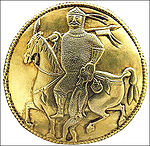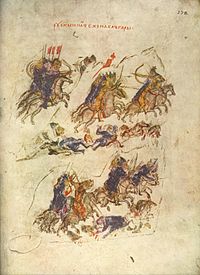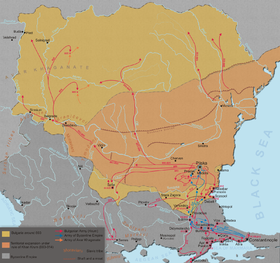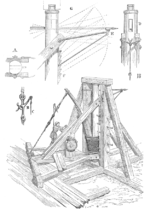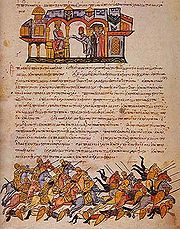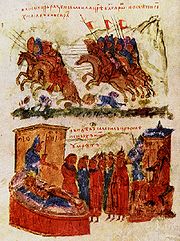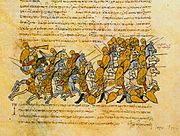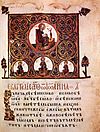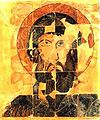- Medieval Bulgarian army
-
Medieval Bulgarian army Participant in the wars of the Bulgarian Empire 
Khan Krum feasts with a skull cup made of Emperor Nicephorus Is head following the victory in the battle of Pliska.Active 632 - 1422 AD Leaders Bulgarian Emperor (Commander-in-chief) Area of
operationsBalkans, Pannonia, Ukrainian Steppes Strength c. 60,000 (9th-10th century) Part of Bulgarian Empire Allies Slavs, Pechenegs, East Franks, Cumans Opponents Byzantines, Avars, Hungarians, the Caliphate, Franks, Serbs, Rus', Crusader states, Pechenegs, Khazars, Mongols, Ottomans and others The medieval Bulgarian army was the primary military body of the First and the Second Bulgarian Empires. During the first decades after the foundation of the country, the army consisted of a Bulgar cavalry and a Slavic infantry. The core of the Bulgarian army was the heavy cavalry, which consisted of 12,000–30,000[1] heavily armed riders. At its height in the 9th and 10th centuries, it was one of the most formidable military forces in Europe and was feared by its enemies. There are several documented cases of Byzantine commanders abandoning an invasion because of a reluctance to confront the Bulgarian army on its home territory.[2][3][4]
The army was intrinsically linked to the very existence of the Bulgarian state. Its success under Tsar Simeon I marked the creation of a wide-ranging empire, and its defeat in a prolonged war of attrition in the early 11th century meant the end of Bulgarian independence. When the Bulgarian state was reestablished in 1185, a series of capable emperors achieved a remarkable string of victories over the Byzantines and the Western Crusaders, but as the state and its army fragmented in the 13th and 14th centuries, it proved unable to halt the Ottoman advance, which resulted in the conquest of all of Bulgaria by 1422. It would not be until 1878, with the Liberation of Bulgaria, that a Bulgarian military would be restored.
Contents
History
7th-8th century
The early Bulgars were a warlike people and war was part of their everyday life, with every adult Bulgar obliged to fight. The early Bulgars were exclusively horsemen: in their culture, the horse was considered a sacred animal and received special care.
The supreme commander was the khan, who mustered the army with the help of the aristocracy. The military ranks from lowest to highest were bagain, bagatur, boil, tarkhan. The permanent army consisted of the khan's guard of select warriors, while the campaign army consisted practically of the entire nation, assembled by clans. In the field, the army was divided into right and left wings.
The Bulgars were well versed in the use of stratagems. They often held a strong cavalry unit in reserve, which would attack the enemy at an opportune moment. They also sometimes concentrated their free horses behind their battle formation to avoid surprise attacks from the rear.They used ambushes and feigned retreats, during which they rode with their backs to the horse, firing clouds of arrows on the enemy. If the enemy pursued disorganized, they would turn back and fiercely attack them. According to contemporary historians, the Bulgars "could see in the dark like bats"[5] and often fought at night.
“ When they make their enemies take to flight, they [...] are not content, as the Persians, the Romans [Byzantines] and other peoples, with pursuing them a reasonable distance and plundering their goods, but they do not let up at all until they have achieved the complete destruction of their enemies.[6] ” —On the tactics employed by the Bulgars,
Strategikon of Maurice, Ch. 13.2The Bulgarian army was well armed according to the Avar model: the soldiers had a sabre or a sword, a long spear and a bow with an arrow-quiver on the back. On the saddle they hung a round shield, a mace and a lasso, which the Bulgarians called arkani. On their decorated belts the soldiers carried the most necessary objects such as flints and steel, a knife, a cup and a needle case. The heavy cavalry was supplied with metal armour and helmets. The horses were also armoured. Armour was of two types — chain-mail and plate armour. The commanders had belts with golden or silver buckles which corresponded to their rank and title.[5]
The army had iron discipline, with the officers vigorously checking if everything was ready before a battle. For a horse that was undernourished or not properly taken care of, the punishment was death. The soldiers were under threat of a death penalty when having a loose bow-string or an unmaintained sword; or even if riding a war horse in peacetime.[7]
The infantry of the newly formed state was composed mainly of Slavs, who were generally lightly armed soldiers, although their chieftains usually had small cavalry retinues. The Slavic footmen were equipped with swords, spears, bows and wooden or leather shields. However, they were less disciplined and less effective than the Bulgar cavalry.
In 680, the Byzantines under Constantine IV were crushed in the battle of Ongal and were forced to conclude a humiliating peace treaty by which they de jure acknowledged the formation of a Bulgarian state on their former territory.[8] In 718, a Bulgarian intervention was crucial in the repulsion of the Second Arab Siege of Constantinople. According to contemporaries, the Arabs feared the Bulgarian army and built trenches to protect themselves from a cavalry charge. In the decisive battle in the summer that year the Bulgarians slaughtered between 20,000 and 32,000 Arabs.[9] Apart from engaging in battle to the south, the Bulgarians had to fight the Avars to the north-west[10] and the Khazars to the north-east. After bloody fights between the Dnester and the Dneper rivers, the Khazar threat was eliminated but the founder of the Bulgarian state Khan Asparukh perished in one of the battles in 700.[11]
Krum's dynasty
On the turn of the 9th century, the Bulgarian Empire was on the rise. Following the victory over the Byzantines at Marcelae in 792, the country overcame a 50-year crisis and entered the new century stronger and consolidated. During the first years of his reign, Khan Krum destroyed the Avar Khaganate and doubled Bulgaria's territory, taking over the fertile Pannonian Plain and the salt and gold mines of Transylvania. Krum achieved major victories over the Byzantine Empire, annihilating the Byzantine armies in the battle of Pliska (811)[12] and at Versinikia (813), while capturing the important city of Sofia in 809.
“ Simeon arrived, leading a large army, which was divided into many squads, some armed with golden shields and golden spears, others with silver shields and silver spears, third with weapons of every colour and all dressed in iron.[13] ” —Theophanes
The Byzantine historian Pseudo-Simeon stated that Krum sent a 30,000 strong cavalry, "the whole armoured with iron",[14] which devastated Thrace. According to inscriptions found in the region of Pliska, Preslav, Madara and Shabla in north-eastern Bulgaria, armaments for 1,713 heavy riders were available.[15] Assuming that the surviving inscriptions are around 1/10 of the total number, that makes 17,130 men only in the so called "inner region" of Bulgaria. After comparison with the data of Pseudo-Simeon, it can be assumed that the heavy cavalry component of the Bulgarian army numbered between 17-20,000 and 30,000 men, depending on the level of mobilization.[16] During the end of the 9th and the beginning of the 10th centuries, Emperor Simeon the Great was able to lead in battle more than 60,000 soldiers.[17]
 The Bulgarians crush the Byzantine army in the battle of Versinikia.
The Bulgarians crush the Byzantine army in the battle of Versinikia.
Traditionally, the army's commander-in-chief was the ruler. The second in the chain of command was the kavkhan who led the army during the Emperor's absence. The third most important title in the hierarchy was the ichirgu-boil who commanded the garrison of the capital. In the field, the army was divided into three parts: center, right flank and left flank. The center was commanded by the ruler, the left flank by the kavkhan and the right flank by the ichirgu-boil.[18] Other higher military ranks included the tarkhan which was equal to the Byzantine strategos according to Stephen Runciman,[19] and the higher officers were called bagain. All higher military ranks were part of the Bulgarian nobility called bolyars or boils.
Decline under Peter I
During the long years of warfare under Tsar Simeon I the Great (893-927), the country was exhausted.[20] The constant wars were unpopular enough so that 20,000 people sought refuge in Byzantium because of Simeon's "warlike rush and relentless intentions".[21] His successor Peter I concluded a favourable peace treaty with the Byzantines, but the situation inside the country saw no improvement. There were many reasons for the decline — some historians dismiss Peter I as a weak ruler, incapable of handling his own family (two of his brothers rose up against him). Furthermore, in the mid-10th century the new Bogomil heresy spread itself widely over the country.[20][22] The Bogomils preached that people must not follow secular authorities, pay taxes or enroll in the army. As a result the Bulgarians were unable to stop the Magyars, who looted and plundered the countryside, further contributing to the grim situation of the state. When the Byzantines paid the Rus' knyaz Svyatoslav I to invade Bulgaria in 968, Peter I could send only 30,000 men against the 60,000 strong invading force.[23] During the Rus' invasion between 968 and 971 the Bulgarians de facto lost control of the north-eastern parts of their country, including the capital Preslav, and in 970, Svyatoslav massacred 300 Bulgarian nobles, the elite of the Bulgarian nation and army, in Silistra.[16][24]
Cometopuli dynasty
The fall of the north-eastern parts of the Bulgarian Empire under Byzantine rule and the decimation of its military elite had a severe impact on the Bulgarian army,[25] especially since most of the heavy cavalry which was instrumental in the earlier successes over the Byzantines was recruited exactly in that region. Contemporary sources continue to mention the existence of a Bulgarian cavalry, but it was much reduced in size and was mostly light cavalry.[26]
“ Even if the sun would have come down, I would have never thought that the Moesian [Bulgarian] arrows were stronger than the Avzonian [Roman, Byzantine] spears... ” —Byzantine writer John Kyriotes Geometres
on the battle of the Gates of Trajan.[27]Consequently, the infantry's importance grew and the tactics changed to reflect the new conditions: the ambush, although employed in the past, now became the cornerstone of Bulgarian tactics — most Bulgarian victories in that period were a result of ambush and careful exploitation of the terrain.[28] During this period, the Bulgarians acquired a reputation for their skillful archers.
Despite those difficulties, Emperor Samuil resisted the Byzantine army, which reached its zenith under Basil II, for nearly half a century. In 976 the Bulgarians led by the Cometopuli brothers reconquered the north-eastern parts of the realm. The first Byzantine attempts for counter-attack were repulsed after the annihilation of a 60,000[29] force in the battle of the Gates of Trajan in 986 in which Basil II himself barely escaped. In the following decade the Bulgarians took Thessaly, destroyed the Principality of Duklja, advanced deep to the south as far as Corinth on the Peloponnese peninsula and campaigned in Dalmatia and Bosnia.
 The battle of Spercheios.
The battle of Spercheios.
However, a major defeat at the battle of Spercheios in 996 signaled that the tide of the war had begun to change in the Byzantines' favour. From 1001 onwards, Basil II launched yearly campaigns into Bulgarian territory, methodically taking important cities such as Preslav, Pliska and Vidin, and inflicting several defeats on Samuil.[30] In addition, in 1003 Samuil was involved in a war with the Kingdom of Hungary. After years of campaigning, in 1014, in the decisive battle of Kleidion the Bulgarian army was crushed and 14,000 captured Bulgarian soldiers were blinded[31] and sent to Samuil, who died at the sight of his army on 6 October.
In the battle of Kleidion the Bulgarian army numbered around 20,000 soldiers. According some estimates the total number of the army including the squads of local militia reached a maximum level of 45,000. The Byzantine historian Georgius Monachus Continuatus wrote that the Bulgarian army had 360,000 men, a greatly exaggerated number, the actual being 10 times smaller.[32]
Asen dynasty
In 1185 the Bulgarian Empire was restored as a result of the successful Rebellion of Asen and Peter, who founded the new Asen dynasty. The long period of Byzantine rule had left its mark on the Bulgarian army — the titles during the Second Empire were mostly borrowed from Byzantium. In the absence of the Emperor the commander-in-chief was called velik (great) voivoda; the commander of smaller squads was a voivoda and a strator was the person responsible for the defense of certain regions and the recruitment of soldiers.
In the late 12th century the army numbered 40,000 men-at-arms.[33] The country was able to mobilize around 100,000 men in the first decade of the 13th century (Kaloyan reportedly offered the leader of the Fourth Crusade Baldwin I 100,000 soldiers to help him take Constantinople).[34] In that period the Bulgarian army used large numbers of Cuman cavalry which numbered between 10,000 and 30,000 riders, depending on the campaign. These were drawn from among the Cumans who inhabited Wallachia and Moldavia, and were at least nominally under the suzerainty of the Bulgarian Emperors. The army was well supplied with siege equipment, including battering rams, siege towers and catapults.
“ This combat lasted a long time... There on the field remained the Emperor Baldwin, who never would fly, and Count Louis; the Emperor Baldwin was taken alive and Count Louis was slain. Alas! How awful was our loss! ” —Crusader chronicler Geoffrey of Villehardouin on the battle of Adrianople.[35]
In the first fifty years after the reestablishment of the Empire, the Bulgarians, led by skillful commanders such as Peter IV, Ivan Asen I, Kaloyan and Ivan Asen II, achieved massive military successes. After a number of successful battles between 1185 and 1204, the Byzantine Empire was effectively driven from the lands it held in the northern Balkans, and the Imperial crown and cross.[36] The army of the Crusaders, who established the new Latin Empire, were in turn annihilated in the battle of Adrianople (1205), when their Emperor was captured, and again at Rusion in 1206. The Hungarians were defeated after several fights along the valley of the Morava[disambiguation needed
 ] river in 1202. After several setbacks under Boril I (1207–1218), Ivan Asen II decisively defeated the Despotate of Epirus in the battle of Klokotnitsa, in which the much smaller Bulgarian army outmaneuvered its enemy. In 1241, the Tsar defeated a Mongol army, fighting under Batu Khan and Subutai.
] river in 1202. After several setbacks under Boril I (1207–1218), Ivan Asen II decisively defeated the Despotate of Epirus in the battle of Klokotnitsa, in which the much smaller Bulgarian army outmaneuvered its enemy. In 1241, the Tsar defeated a Mongol army, fighting under Batu Khan and Subutai.Terter and Shishman dynasties
The country and the army declined after Ivan Asen II's death. His successors could not cope neither with the external nor with the internal problems. Mongol, Byzantine and Hungarian invasions were combined with separatism among the nobility and several civil wars. In 1277, a peasant named Ivailo rebelled against Emperor Constantine Tikh. In the ensuing battle the Emperor was defeated and slain, and Ivailo proclaimed himself Emperor of Bulgaria in Tarnovo. Although he managed to defeat both the Mongols and the Byzantines, a plot among the nobility forced him to seek refuge among the Mongol Golden Horde, where he was killed in 1280.[37] The army now numbered less than 10,000 men — it is recorded that Ivailo defeated two Byzantine armies of 5,000 and 10,000 men, and that his troops were outnumbered in both cases.[38]
“ In the country of the people there was no knyaz, no commander, no saviour, no redeemer. Everything vanished under the fear of the Turks. Even the brave hearts of the champions turned into weak feminine hearts. Those who remained alive fairly envied at the dead.[39] ” —The monk Isay, a witness to the Ottoman invasion
After the end of the rebellion of Ivailo, the Bulgarians were no match for the Mongols who plundered the country undisturbed for 20 years. With the reign of Theodore Svetoslav (1300–1321), the situation of the army improved — in 1304 he defeated the Byzantines at Skafida. Under his successor the garrison of Plovdiv numbered 2,000 heavily armed footmen and 1,000 horsemen.[40] In 1330 Michael III Shishman raised a 15,000-strong army[41] to face the Serbs but was defeated at the battle of Velbazhd. Two years later the Bulgarian army numbered 11,000 men.[42]
When the Ottoman Turks invaded Bulgaria and the Balkans in the mid-14th century, the once glorious Bulgarian army was only a shadow of its former self. Feudal disunion and the widespread heretical movements such as Bogomilism, the Adamites or the Varlaamites did not allow the country to maintain a significant force. The Bulgarians relied on their fortified cities and castles for defense, but due to the lack of a common leadership, coordination amongst them was feeble and they were defeated and occupied in detail.
Initially, the Ottoman invasion was not considered as a significant threat by both Bulgarians and Byzantines. For only one decade between 1354 and 1364 the Ottomans conquered virtually the whole of Thrace seizing large cities such as Plovdiv, Boruy, Dianopolis (Yambol) and Adrianople and defeating several small Bulgarian forces.[43] The centuries-old mistrust between Bulgarians and Byzantines spoiled the negotiations between the two empires for an alliance and even led to the last Byzantine-Bulgarian war in 1364.[44] In 1371 a large Bulgarian-Serb army under Vukašin Mrnjavčević and Jovan Uglješa, two feudal lords in Macedonia, was annihilated by the Ottomans under Lala Shahin Pasha at Chernomen and soon the Bulgarian Emperor had to admit the defeat and became a vassal to the invaders.[45] Numerous Bulgarian fortresses in the Rhodope mountains, Sofia valley and eastern Bulgaria were captured one by one over the next twenty years. In 1393 the capital Tarnovo was besieged and seized by the Ottoman Turks and three years later fell Vidin - the last major Bulgarian city. Resistance to the invaders continued until 1422 when the country was fully conquered. The Ottoman invasion was a disaster for the Bulgarian army — the nobility and the leaders of the nation were killed or emigrated and the ordinary people were not allowed to have weapons until the 19th century.
Tactics
The Bulgarian army employed various military tactics. It relied both on the experience of the soldiers and the peculiarities of the terrain. The Balkan mountains played a significant role in the military history of Bulgaria and facilitated the country's defense against the strong Byzantine army which conveyed the Roman military art in the Middle Ages. Most of the nine campaigns of the ambitious Emperor Constantine V to eliminate the young Bulgarian state, which suffered political crisis, failed in the mountain passes of the Balkan. In 811 the whole Byzantine army was destroyed in the Varbitsa pass and in 12th-13th centuries several other Byzantine forces shared that doom. The Bulgarians maintained many outposts and castles which guarded the passes and were able to locate an invading force and quickly inform the high command about any enemy moves.
Another widely used tactic was to make a false retreat and then suddenly attack the enemy — breaking the lines when in pursuit.[46] This trick won many victories, most notably at the battle of Adrianople in 1205 against the Crusaders. Sometimes the Bulgarians left a strong cavalry force in reserve which attacked in the sublime moment and tipped the balance in Bulgarians' favour, for instance in the battle of Anchialus in 917.[17] Ambush was another widely used and very successful strategy especially during the Cometopuli dynasty.
“ Inside the fortress [Sofia] there is a large and elite army, its soldiers are heavily built, moustached and look war-hardened, but are used to consume wine and rakia - in a word, jolly fellows.[47] ” —Ottoman commander Lala Shahin on the garrison of Sofia.
The Bulgarians usually avoided frontal assault and waited the enemy to attack first. After the opponent inevitably breaks his battle formation the Bulgarians would counter-attack with their heavy cavalry. In several battles the Bulgarian troops waited the Byzantines for days until the latter attack — for instance at Marcelae (792) or Versinikia (813) - and scored decisive victories.[46][48] In one of the rare occasions in which the army made a frontal attack on the enemy, the result was a defeat despite the heavy casualties the enemy suffered - battle of Anchialus (763).[49] After a successful battle the Bulgarian would pursue the enemy in depth in order to eliminate as much soldiers as possible and not to allow him to reorganize his forces quickly and effectively. For instance after the victory at Ongal in 680 the Byzantines were chased for 150–200 km. After the success at Anchialus in 917 the Byzantines were not given time to prepare their resistance properly and the result was the annihilation of their last forces in the battle of Katasyrtai.
During war the Bulgarians usually sent light cavalry to devastate the enemy lands on a broad front pillaging villages and small towns, burning the crops and taking people and cattle.[50] During the Second Empire that task was usually assigned to the Cumans. The Bulgarian army was very mobile — for instance prior to the battle of Klokotnitsa for four days it covered a distance three times longer than the Epirote army for a week; in 1332 it covered 230 km for five days.[42]
Siege equipment
The early Bulgarian army was not supplied with strong siege equipment . The Bulgarians used siege machines on a large scale for the first time during the reign of Khan Krum (803-814), when they employed Arab renegades to gain experience. By 814 they possessed a large number of enormous siege machines[51] - battering rams, ballistas, mangonels, catapults, siege towers, machines against battlements.[52] They were transported by 5,000 iron-covered carts, hauled by 10,000 oxen.[53] In addition, after the siege of Mesembria, the Bulgarians captured 36 copper siphons which the Byzantines used to throw the famous Greek fire.
A wide range of siege equipment was also used during the Second Empire.[54] During the siege of Adrianople in 1207, Emperor Kaloyan had 33 catapults and an engineer corps which was tasked with destroying the city walls.[55] In the beginning of the 13th century, during the siege of Varna, the Bulgarians constructed an enormous siege tower which was wider than the moat of the fortress.
Foreign and mercenary soldiers
After the Bulgarians conquered the Avar Khanate in 804-805, Avar soldiers, who were now subjects of the Bulgarian crown, were recruited in the army, especially during the campaign against Nicephorus I in 811, when the Byzantines burned down the capital, Pliska.[56] In the 9th-10th centuries the Bulgarians often resorted to the services of the Pechenegs,[57] who were probably Bulgarian federates. When the Byzantines stirred the Kievan Rus' up against the Empire, the Bulgarian diplomacy in turn used the Pechenegs against Rus'.[23][58]
During the Second Empire, foreign and mercenary soldiers became an important part of the Bulgarian army and its tactics. Since the very beginning of the rebellion of Asen and Peter, the light and mobile Cuman cavalry was effectively used against the Byzantines and later the Crusaders. For instance, fourteen thousand of them were used by Kaloyan in the battle of Adrianople.[59] The Cuman leaders entered the ranks of Bulgarian nobility, and some of them received high military or administrative posts in the state.[60] During the 14th century the Bulgarian army increasingly relied on foreign mercenaries, which included Western knights, Mongols, Ossetians or came from vassal Wallachia. Both Michael III Shishman and Ivan Alexander had a 3,000-strong Mongol cavalry detachment in their armies.[42][61] In the 1350s, Emperor Ivan Alexander even hired Ottoman bands, as did the Byzantine Emperor.
Conflicts
Byzantine-Bulgarian Wars
Battle Date Bulgarian Commander
Byzantine Commander Result Battle of Ongal 680 Asparukh Constantine IV Bulgarian victory Battle of Anchialus 708 Tervel Justinian II Bulgarian victory Battle of Marcelae 756 Vinekh Constantine V Byzantine victory Battle of the Rishki Pass 759 Vinekh Constantine V Bulgarian victory Battle of Anchialus 30 June 763 Telets Constantine V Byzantine victory Battle of Berzitia October 774 Unknown Unknown Byzantine victory Battle of Marcelae 792 Kardam Constantine V Bulgarian victory Siege of Serdica Spring 809 Krum Unknown Bulgarian victory Battle of Pliska 26 July 811 Krum Nicephorus I Bulgarian victory Battle of Versinikia 22 June 813 Krum Michael I Rangabe Bulgarian victory Siege of Adrianople 813 Krum Unknown Bulgarian victory Battle of Bulgarophygon Summer 896 Simeon I Unknown Bulgarian victory Battle of Anchialus 20 August 917 Simeon I Leo Phocas Bulgarian victory Battle of Katasyrtai August 917 Simeon I Leo Phocstyleas Bulgarian victory Battle of Pigae March 922 Theodore Sigritsa Potas Argirus Bulgarian victory Battle of the Gates of Trajan 16 July 986 Samuil Basil II Bulgarian victory Battle of Salonica Summer 996 Samuil Gregory Taronites Bulgarian victory Battle of Spercheios 16 July 996 Samuil Nikephoros Ouranos Byzantine victory Battle of Skopie 1004 Samuil Basil II Byzantine victory Battle of Kreta 1009 Samuil Basil II Byzantine victory Battle of Salonica July 1014 Nestoritsa Botaniates Byzantine victory Battle of Kleidion 29 July 1014 Samuil Basil II Byzantine victory Battle of Strumitsa August 1014 Gavril Radomir Botaniates Bulgarian victory Battle of Bitola Autumn 1015 Ivats George Gonitsiates Bulgarian victory Battle of Setina Autumn 1017 Ivan Vladislav Basil II Byzantine victory Battle of Dyrrhachium February, 1018 Ivan Vladislav Nicetas Pegonites Byzantine victory Battle of Salonica 1040 Peter II Delyan Michael IV Bulgarian victory Battle of Salonica Autumn 1040 Alusian Unknown Byzantine victory Battle of Ostrovo 1041 Peter II Delyan Michael IV Byzantine victory Siege of Lovech Spring 1190 Unknown Isaac II Angelos Bulgarian victory Battle of Tryavna Spring 1190 Ivan Asen I Isaac II Angelos Bulgarian victory Battle of Arcadiopolis 1194 Ivan Asen I Basil Vatatsi Bulgarian victory Battle of Serres 1196 Ivan Asen I Isaac Bulgarian victory Siege of Varna 21–24 March 1201 Kaloyan Unknown Bulgarian victory Battle of Klokotnitsa 9 March 1230 Ivan Asen II Theodore Komnenos Bulgarian victory Battle of Adrianople 1254 Unknown Unknown Byzantine victory Battle of Devina 17 July 1279 Ivailo Murin Bulgarian victory Battle of Skafida 1304 Theodore Svetoslav Michael IX Bulgarian victory Battle of Rusokastro 18 July 1332 Ivan Alexander Andronikos III Bulgarian victory Bulgarian-Croatian Wars
Battle Date Bulgarian Commander
 Croatian Commander
Croatian CommanderResult Battle of the Bosnian Highlands 27 May 927 Alogobotur Tomislav Bulgarian victory Bulgarian-Hungarian Wars
 The Bulgarian army flees to Silistra after a defeat by the Hungarians in 895.
The Bulgarian army flees to Silistra after a defeat by the Hungarians in 895.
Battle Date Bulgarian Commander
 Hungarian Commander
Hungarian CommanderResult Battle of Southern Buh 896 Simeon I Unknown Bulgarian victory Bulgarian-Latin Wars
Battle Date Bulgarian Commander
 Latin Commander
Latin CommanderResult Battle of Adrianople 14 April 1205 Kaloyan Baldwin I Bulgarian victory Battle of Serres June 1205 Kaloyan Unknown Bulgarian victory Battle of Rusion 31 January 1206 Kaloyan Thierry de Termond Bulgarian victory Battle of Rodosto February 1206 Kaloyan Unknown Bulgarian victory Battle of Messinopolis 4 September 1207 Unknown Boniface of Montferrat Bulgarian victory Battle of Boruy June 1205 Boril Henry I Bulgarian victory Battle of Philippopolis 31 June 1208 Boril Henry I Latin victory Siege of Constantinople 1235 Ivan Asen II John of Brienne Two Year Truce Bulgarian-Ottoman Wars
Battle Date Bulgarian Commander
 Ottoman Commander
Ottoman CommanderResult Battle of Peritor 7 July 1345 Momchil Uner beg Bulgarian victory Battle of Ihtiman 1355 Michael Asen Unknown Ottoman victory Battle of Chernomen 26 September 1371 Valkashin and Uglesha Lala Shahin Pasha Bulgarian victory Siege of Tarnovo 17 July 1393 Evtimiy Chelebi Ottoman victory Bulgarian-Serbian Wars
Battle Date Bulgarian Commander
 Serbian Commander
Serbian CommanderResult Battle of Velbazhd 28 July 1330 Michael Shishman Stefan Dečanski Bulgarian victory See also
Notes
- Note that the works Byzantine authors are usually from their Bulgarian edition ГИБИ (Гръцки Извори за Българската История - Greek Sources for the Bulgarian History)
- ^ Димитров, Б. Българите — първите европейци, с. 41, УИ "Св. Климент Охридски", София, ISBN 954-07-1757-4
- ^ Andreev, J. The Bulgarian Khans and Tsars (Balgarskite hanove i tsare, Българските ханове и царе), Veliko Tarnovo, 1996, p. 111 ISBN 954-427-216-X
- ^ Leo Diakonos, ibid., pp. 62-63 — Leo Diakonos wrote: "...to bring his armies to those dangerous places and to sent them to the Bulgarians who would slaughter them as cattle, because it is said that the Romans often got into the bad places of Bulgaria and were met by their doom. That is why he decided to retreat with his army and marched back to Byzantium."
- ^ Andreev, J. The Bulgarian Khans and Tsars (Balgarskite hanove i tsare, Българските ханове и царе), Veliko Tarnovo, 1996, p. 158 ISBN 954-427-216-X
- ^ a b Cited in Халенбаков, О. Детска енциклопедия България: Държавата - 681 г., с. 13
- ^ Maurice's Strategikon, translated by George T. Dennis, p. 117
- ^ Cited in Халенбаков, О. Детска енциклопедия България: Държавата - 681 г., с. 12
- ^ Петров П. Хр., Към въпроса за образуването на първата българска държава, Славянска филология, V, София, 1963, стр. 89—112
- ^ Andreev, J. The Bulgarian Khans and Tsars (Balgarskite hanove i tsare, Българските ханове и царе), Veliko Tarnovo, 1996, p. 26 ISBN 954-427-216-X
- ^ Zlatarski, V. History of the Bulgarian state in the Middle Ages, p. 214 Sofia, 1971,
- ^ Andreev, J. The Bulgarian Khans and Tsars (Balgarskite hanove i tsare, Българските ханове и царе), Veliko Tarnovo, 1996, p. 19 ISBN 954-427-216-X
- ^ Steven Lowe. "Bulgaria: Beginning". http://www.redkaganate.org/tribelist/bulgaria.shtml#begin. Retrieved 15 September 2009.
- ^ Cited in Andreev, J. The Bulgarian Khans and Tsars (Balgarskite hanove i tsare, Българските ханове и царе), Veliko Tarnovo, 1996, p. 19 ISBN 954-427-216-X
- ^ Symeon Magister, ibid., p. 616
- ^ Венедиков, София, с. 53-54
- ^ a b Иванов, И. КЪМ ВЪПРОСА ЗА БЪЛГАРСКАТА ВОЕННА МОЩ ПРЕЗ ПОСЛЕДНАТА ЧЕТВЪРТ НА X И НАЧАЛОТО НА XI ВЕК. ЗАЩО БЪЛГАРИЯ ЗАГУБИ ДВУБОЯ С ВИЗАНТИЯ?
- ^ a b Battle of Anchialus
- ^ Бешелиев, В. Прабългарски епиграфски паметници, с. 37
- ^ Steven Runciman, A history of the First Bulgarian Empire, London 1930, p. 286
- ^ a b Steven Lowe. "Bulgaria: First Bulgarian Empire". http://www.redkaganate.org/tribelist/bulgaria.shtml#first. Retrieved 15 September 2009.
- ^ Andreev, J. The Bulgarian Khans and Tsars (Balgarskite hanove i tsare, Българските ханове и царе), Veliko Tarnovo, 1996, p. 104 ISBN 954-427-216-X
- ^ Nicolaus Papa. Response, p. 1015
- ^ a b Cedrenus: II, p. 383
- ^ Драгиев, Ч. Детска енциклопедия България: Години на изпитание, с. 14
- ^ Божилов, 1979; c. 122
- ^ Zlatarski, V. History of the Bulgarian state in the Middle Ages, p. 600 Sofia, 1971,
- ^ Ioannis Geometrae Carmina varia. Migne, Patrol. gr., t. 106, col. 934
- ^ Skylitzes-Cedrenus, pp. 278, 285, 288
- ^ При Самуил стигаме до Коринт и Далмация
- ^ Steven Lowe. "Bulgaria: Basil the Bulgar-Slayer". http://www.redkaganate.org/tribelist/bulgaria.shtml#basil. Retrieved 15 September 2009.
- ^ Ioannes Scylitzes, Historia, р. 458
- ^ Nikolov, Centralism and Regionalism in Early Medieval Bulgaria , p. 131
- ^ Emperor Peter IV offered a 40,000-strong army to Frederick I, Holy Roman Emperor against the Byzantines in return of recognition of his Imperial title — Andreev, J. The Bulgarian Khans and Tsars (Balgarskite hanove i tsare, Българските ханове и царе, Veliko Tarnovo, 1996, p. 145 ISBN 954-427-216-X
- ^ Andreev, J. The Bulgarian Khans and Tsars (Balgarskite hanove i tsare, Българските ханове и царе, Veliko Tarnovo, 1996, p. 166 ISBN 954-427-216-X
- ^ Geoffrey de Villehardouin: Memoirs or Chronicle of The Fourth Crusade and The Conquest of Constantinople p. 94
- ^ See Andreev, pp. 154-155 - In the battle of Tryavna in 1190 the Bulgarians captured the Imperial treasure of the Byzantine Emperors including the crown, the golden cups of the nobility and the Imperial cross made up of solid gold with a piece of the Holy Cross built in inside. A Byzantine priest threw it into the river so that it would be never found it but it was soon recovered by the Bulgarians. Throughout the 13th century that treasure was showed off during processions and celebrations in Tarnovo as described by the Byzantine historian George Acropolites.
- ^ Steven Lowe. "Bulgaria: Second Bulgarian Empire". http://www.redkaganate.org/tribelist/bulgaria.shtml#second. Retrieved 15 September 2009.
- ^ Andreev, J. The Bulgarian Khans and Tsars (Balgarskite hanove i tsare, Българските ханове и царе, Veliko Tarnovo, 1996, p. 227 ISBN 954-427-216-X
- ^ Cited in Халенбаков, О. Детска енциклопедия България: Залезът на царете, с. 16
- ^ Andreev, J. The Bulgarian Khans and Tsars (Balgarskite hanove i tsare, Българските ханове и царе, Veliko Tarnovo, 1996, p. 253 ISBN 954-427-216-X
- ^ Cantacuzenos, I, p. 429. 19
- ^ a b c Andreev, J. The Bulgarian Khans and Tsars (Balgarskite hanove i tsare, Българските ханове и царе, Veliko Tarnovo, 1996, p. 269 ISBN 954-427-216-X
- ^ Angelov, D. Certains aspects de la conquete des peuples balkaniques par des turks — BSI, 1956, 162, p. 237
- ^ Ioannes Cantacuzenus. Historiarum... 3, p.362
- ^ Синодник царя Борила, с. 89
- ^ a b Haldon J.F., Warfare, State and Society in the Byzantine World, 565–1204, L., 1999, p. 211
- ^ Cited in Халенбаков, О. Детска енциклопедия България: Залезът на царете, с. 18
- ^ Beševliev V., Die protobulgarische Periode der bulgarischen Geschichte, Amsterdam, 1980, S. 253–254
- ^ Georgius Monachos, p. 762
- ^ For instance Niketas Choniates wrote: "Surrounded from all sides like bees on wax, he [the Emperor] (Isaac II Angelos), did not know to whom of the suffering from attacks by the enemy to help first, to whom to delay help..." - see Zlatarski, The Bulgarian state during the Asen dynasty, pp. 73-74
- ^ Zlatarski, V. History of the Bulgarian state in the Middle Ages, p. 361, Sofia, 1971
- ^ Symeon Magister, ed. Bon., 617
- ^ Symeon Magister, ibid., p. 617
- ^ Nicetas Choniata. Historia, p. 835
- ^ Andreev, J. The Bulgarian Khans and Tsars (Balgarskite hanove i tsare, Българските ханове и царе, Veliko Tarnovo, 1996, p. 172 ISBN 954-427-216-X
- ^ Andreev, J. The Bulgarian Khans and Tsars (Balgarskite hanove i tsare, Българските ханове и царе, Veliko Tarnovo, 1996, p. 47 ISBN 954-427-216-X
- ^ Steven Lowe. "The Magyars of Hungary". http://www.redkaganate.org/tribelist/magyar.shtml#begin. Retrieved 15 September 2009.
- ^ Zlatarski, V. History of the Bulgarian state in the Middle Ages, pp. 359-360, Sofia, 1971
- ^ Andreev, J. The Bulgarian Khans and Tsars (Balgarskite hanove i tsare, Българските ханове и царе, Veliko Tarnovo, 1996, p. 167 ISBN 954-427-216-X
- ^ Andreev, J. The Bulgarian Khans and Tsars (Balgarskite hanove i tsare, Българските ханове и царе, Veliko Tarnovo, 1996, pp. 167-169 ISBN 954-427-216-X
- ^ Nic. Gregoras. I, р. 455. 7-9.
References
- (English) Lang, D. M. (1976). The Bulgarians from Pagan Times to the Ottoman Conquest. Southampton: Thames & Hudson.
- (English) Lowe, Stephen. Byzantium’s Neighbours: 1. The Bulgarians. Archived from the original on 2009-10-27. http://web.archive.org/web/20091027115350/http://www.geocities.com/egfroth1/Bulgarians.
- (Bulgarian) Pavlov, P. (2005). "Commanders and allies Cumans, Tatars and Alans in the Second Bulgarian Empire" (in Bulgarian). Rebels and adventurers in Medieval Bulgaria. Varna: LiterNet. http://liternet.bg/publish13/p_pavlov/buntari/voenachalnici.htm.
- (English) Runciman, Stephen (1930). A history of the First Bulgarian Empire. London: G. Bell & Sons. http://www.promacedonia.org/en/sr/index.html.
- (Bulgarian) Zlatarski, Vasil (1971) (in Bulgarian). History of the Bulgarian state in the Middle Ages: Part 1. Sofia: IInd edition. http://www.promacedonia.org/vz1a/index.html.
- (Bulgarian) Zlatarski, Vasil (1971) (in Bulgarian). History of the Bulgarian state in the Middle Ages: Part 2. Sofia: IInd edition. http://www.promacedonia.org/vz1b/index.html.
- (English) Bulgaria, retrieved on 16 September 2009
- (Bulgarian) Annex 9: The siege machines during the reign of Khan Krum
Categories:- Bulgarian Empire
- Military history of Bulgaria
- Military history of the Mediterranean
- Military units and formations of the Middle Ages
- Medieval armies
Wikimedia Foundation. 2010.

